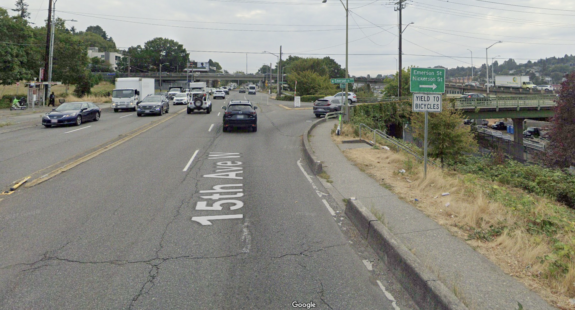SDOT’s most recent plans for the department’s 15th Ave NW repaving project, which includes the Ballard Bridge, would make very few if any tangible safety improvements for people biking. But neighbors are organizing in an effort to get some key safety improvements added to the $16.2 million project.
Ballard-Fremont Greenways created an effort they call “Reconnect Ballard,” a detailed document (PDF) filled with good idea for making the area around the project safer for all road users while also improving safety and accessibility for people walking, biking and rolling. It also includes relevant citations to Seattle plans and policies — including the Bicycle and Pedestrian Master Plans and the Complete Streets Ordinance — that the project currently fails to meet. You can send a letter to elected leaders and SDOT staff supporting Reconnect Ballard using their handy online tool. You can also complete SDOT’s online survey before it closes January 13 (Friday), though it is more to give them data for minimizing construction impacts and does not directly address safety improvement.
In the SDOT project page’s frequently asked questions section, the answer to why there are no bicycle improvements in this project is short: “Bike facilities on the Ballard Bridge are outside the scope of this project.” Seattle’s complete streets ordinance begs to differ, however, however, stating that “SDOT will plan for, design and construct all new City transportation improvement projects to provide appropriate accommodation for pedestrians, bicyclists, transit riders, and persons of all abilities, while promoting safe operation for all users.” The ordinance includes a list of exceptions, but none from my reading would preclude most of the suggested improvements in the Reconnect Ballard document. If I’m reading it correctly, the project will need “documented exception” from the Director of Transportation to move forward legally.
Perhaps the biggest single project addition Ballard-Fremont Greenways seeks is to add a crosswalk signal at NW 51st Street to help people cross the pseudo-highway. The group also suggest building a railing on top of the barrier between the roadway and the sidewalks. They also have ideas for creating a safe crosswalk at W Emerson Street for people using the west sidewalk on 15th. The most recently-released 60% design would leave the notorious “merge of death” in place, which is frankly unacceptable and one of the more clear-cut examples of how the project does not meet the legal requirements in the Complete Streets Ordinance.

Their proposed solution would be something like this:

Reconnecting Ballard also includes a lot of places where access to the bridge sidewalks could be improved and ideas for calming traffic by reducing excessive lane widths that encourage speeding. In some places on or near bridge ramps, lanes were 22 feet wide, double the 11-foot standard.
Finally, the group asks for SDOT to study more significant improvements like repurposing a lane on the bridge to create safe bike lanes. For example, they suggest studying how construction lane closures impact traffic so that the city can get an idea for how a bike lane in the same location might work.
Volunteers for Ballard-Fremont Greenways have put in an enormous amount of work here to give the city ideas that ideally SDOT would have pursued from the very beginning. But it’s never too late to get on board and start making Seattle safer. As Ryan Packer reported for the Urbanist, the project budget is $16.2 million and is funded largely through the Move Seattle Levy. “But it largely serves to represent a huge lost opportunity to move a high volume, high speed corridor closer toward what the city’s goals and priorities all suggest it should be: a street that prioritizes people both inside and outside cars.”
Especially with plans to build the Ballard light rail station on 15th Ave NW, Seattle needs to reimagine the role this street plays in our community. It is not a highway, yet it is designed as though it is. The neighborhood around it has changed dramatically, and the street needs to change as well. Rebuilding a street design that we know to be dangerous is irresponsible. Luckily, a group of neighbors have come to the rescue with a whole document full of ways the project can be changed to better meet our city’s goals.








Comments
6 responses to “Neighbors create detailed plan for how the 15th Ave NW paving project can ‘Reconnect Ballard’”
Ballard-Fremont Greenways did an awesome job creating these recommendations. I really hope the city listens to them and makes these changes.
Is SDOT’s reticence political or a result of entrenchment ?
The City skated by its obligation to improve bike and pedestrian access on the Ballard Bridge by calling the planned seismic improvement project “phase 1” of the project, and deferring bike/ped pathway widening to an unfunded and unscheduled “phase 2”. This despite the planning study of pathway expansion options in 2014 and the bridge rehab vs replacement study in 2020 funded by the Move Seattle levy that show pathway widening options possible at 5 to 10 percent of a ~$400M-$500 full rehabilitation project. Now, here we go again. The neglect of responsibility for improving the bridge for biking and walking becomes the excuse for neglect of responsibility for improving 15th Ave NW for biking and walking. Speeches at City Hall and at sites of fatal crashes don’t mean much when there is no action taken on projects of this magnitude.
I’m really glad to see the emphasis on complete interconnect – so the bikepath/walkway user can actually reach the grocery store/home/work/park/bus/train without confronting some difficult obstacle near the end.
By the way I sometimes DRIVE through the intersection pictured at the top of the post, and it’s sketchy in a VAN.
The “Yield to Bicycles” sign is especially insufficient because its placement could be read to imply that only people taking the Emerson/Nickerson exit need to yield to bikes, which would in turn imply that, you know, there’s a way to cross just the exit.
https://cascade.org/blog/2015/05/connect-ballard-releases-proposed-near-term-solution-ballard-bridge